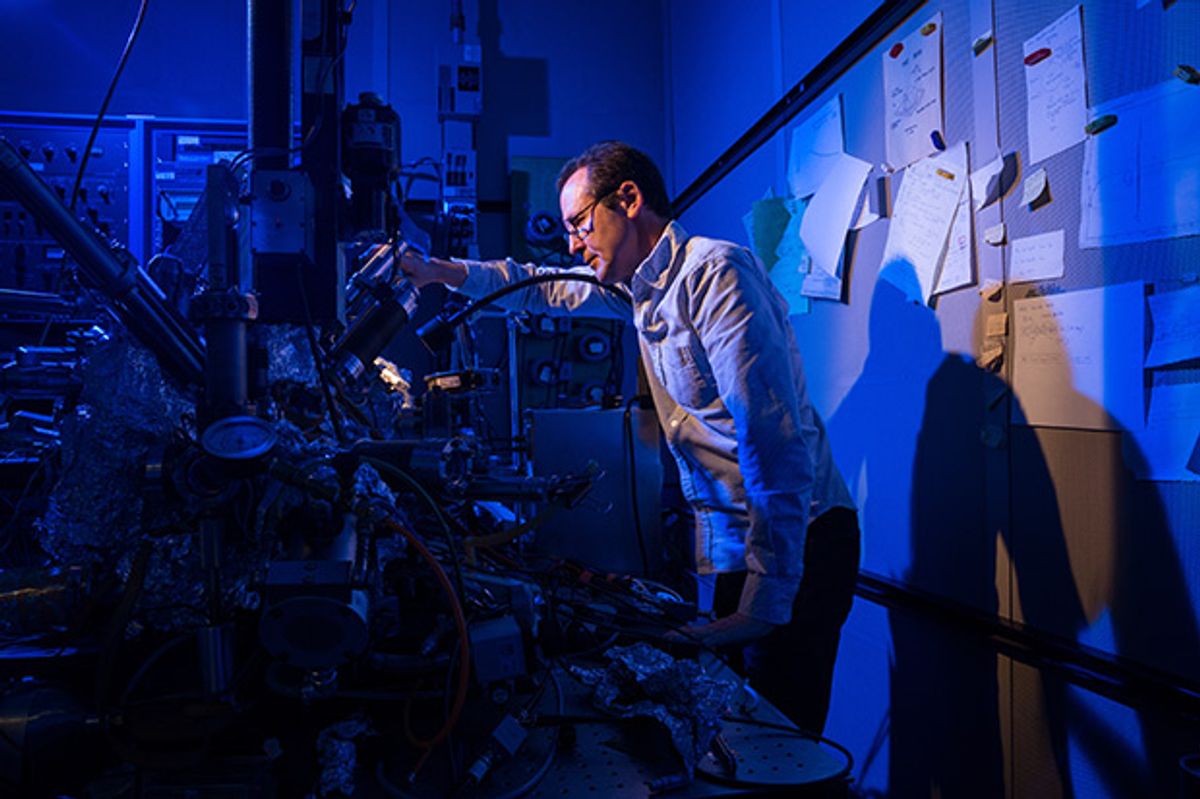An international team of researchers have produced the world’s smallest magnet and demonstrated that it’s possible to use that magnet—an individual atom—to store a single bit of data.
Until this latest research, led by teams at IBM Research Almaden and École Polytechnique Fédérale de Lausanne (EPFL) in Switzerland, molecules were the smallest-ever data storage units. To put this advance in context, think about it like this: With one bit per atom, it would be conceivable to store an entire iTunes library of 35 million songs on a device no bigger than a credit card.
This latest result stems from work about which we reported on 6 March: IBM Research Almaden developed an electron-spin resonance (ESR) sensor consisting of a single iron atom on the tip of a scanning tunneling microscope (STM). STMs detect the tunneling of electrons between the ultra-sharp probe as it’s scanned across a surface, when it is combined with the iron atom it can measure the magnetic field of an atom more directly and with greater sensitivity than any other method.
Now we know what the scientists have been using their newly developed iron-atom sensor for: to detect the magnetic fields of holmium atoms. The holmium atom comes from a family of rare earth metals that are known for their high level of magnetism. Prior to the development of the iron-atom sensor, there didn’t appear to be a way to both read and manipulate the magnetic pole of the holmium atoms using only an STM without disrupting it.
By being able to read the holmium atoms magnetic pole (north or south) with the iron atom, the holmium atom can be used to store the zeros and ones used in digital logic. In essence, the researchers have developed a read-write method for storing data on a single atom with the combination of an STM with an iron atom that serves as an ESR sensor.
In the latest research described in the journal Nature, the researchers found that they could place the iron atom within a nanometer of the holmium atom so that the iron atom could read the north and south of its magnetic poles (the 0 and 1 of digital logic) without the sensor atom being affected by the electrical current that turns the holmium atom’s magnetic state from north to south. Because the iron and holmium atoms can be so closely spaced, it’s conceivable that engineers could create magnetic storage that is a thousand times as dense as today’s hard disk drives and solid state memory chips.
In the video below, some history of the STM is provided, along with how, in this case, it helps serve as a read-write data storage system for single atoms.
The arrangement of this single-atom, read-write memory storage system starts by placing the atoms on a substrate of magnesium oxide that serves as an insulating layer between the metal electrodes beneath it and the magnetic atoms on top of it. The holmium atom—which will hold its polarization for a long time under many conditions including the presence of magnets, making it ideal as a data storage medium—is attached to this magnesium oxide surface.
When the tip of the STM introduces current to the holmium atom, it flips the magnetic north and south poles of the atom, changing its state from 1 to 0 or vice versa. This step more or less corresponds to the “write” process in a hard disk drive.
The “read” process involves the iron atom detecting the magnetic state of the holmium atom. This achieved by exploiting a phenomenon known “precess.” When atoms that have unpaired electron spins are placed in a magnetic field, they rotate around the magnetic field at a precise frequency. This frequency depends on the field strength and the atom's magnetic moment, which is the strength of the atom's magnetism.
The researchers apply a magnetic field to the microscope and then a high-frequency voltage to the tunnel junction of the STM. When the frequency of the voltage matches the frequency of the spin precession, the spin is driven away from its thermal equilibrium, which is primarily aligned with the magnetic field. The iron sensor on the tip of the STM detects this change in orientation because the frequency sweeps through the resonance frequency, making for a sharp change in tunnel current that appears exactly at the resonant frequency. This resonance frequency moves in response to nearby magnetic atoms.
“The physical principle is the same as for magnetic resonance imaging, except that we detect electron precession instead of nuclear precession, and we address individual atoms instead of billions of them, by positioning the tip over the atom of interest,” Chris Lutz, staff scientist at IBM Almaden, explained to IEEE Spectrum earlier this week.
Lutz cautions that we shouldn’t expect this technology to replace our computer hard-disk drives anytime soon. The STMs that perform this work have to be kept at four degrees Kelvin in order to keep the atoms from moving around, which obviously is not going to be possible for a mobile handset in your pocket. There is also a long list of scientific and engineering steps that loom ahead, such as manufacturability.

That said, Lutz and his team are clearly enthusiastic about the prospects that this latest line of research has turned up. A few years ago, they looked at this class of magnetic atoms only to be disappointed that they couldn’t do much with them because their electron structure made it difficult for the STMs to work with them.
But now, with the discovery of their new ESR sensor in the form of a single iron atom, the possibilities seem endless. It’s too early to tell whether it will ultimately lead to a new type of computer data storage. But the journey might yield many more breakthroughs than just computer memory.
Dexter Johnson is a contributing editor at IEEE Spectrum, with a focus on nanotechnology.



